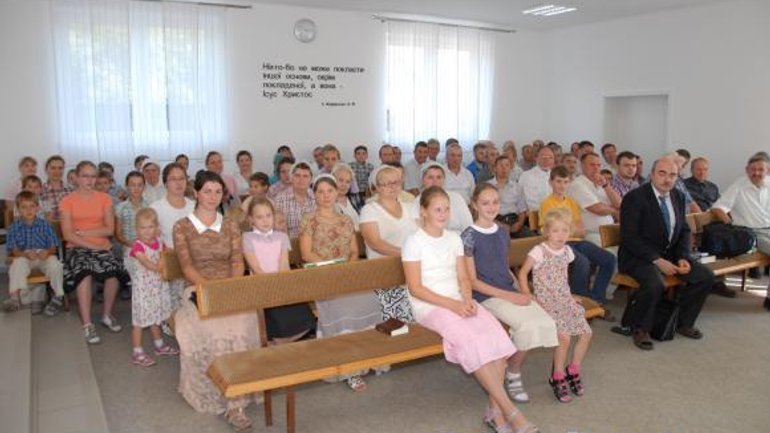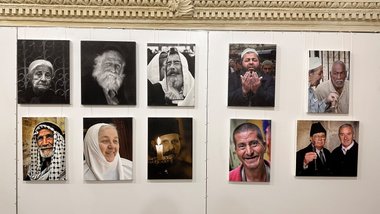Mennonites: German diaspora in southern Ukraine

At that time, the new lands were large deserted steppes. In order to settle and cultivate them, the government of Catherine II invited foreign colonists. They were mostly Germans. A considerable part of them were the Mennonites from Prussia and Danzig.
In 1786, Prince Potemkin sent to Germany his authorized representative R. Trappe to “recruit colonists for the new Russian territory.” The first Mennonite families settled on the island of Khortytsya in the tract of the Dnipro, in the Tauride province on the Molochna River (current Melitopol and Berdyansk districts), Yekaterinoslav province (now Dnipropetrovsk).
Who are the Mennonites?
This religious movement was established in XVI century in the Netherlands by a former Catholic priest Menno Simons. Despite significant differences on specific issues of the doctrine, most Mennonites adhere to the pre-Dordrecht confession, which was finally formulated at a conference held in 1632 in the Dutch city of Dordrecht (Dort). Millennialism – a belief in the imminent establishment of millennial Kingdom of God on earth is typical for the Mennonites.
The Mennonite baptism is performed in a conscious age when a person is capable of making his own decision. Besides, the baptism is not considered a sacrament, but the rite to be performed (in most groups by pouring) for persons at the age from 12 to 18 years. The Mennonites practice the Lord’s Supper (communion as they are called). At the same time, the Mennonites do not believe in the real presence of Jesus Christ in the Eucharist. Another Mennonite rite is mutual washing of feet. Sharing fraternal kisses is also considered a mandatory ceremony.
Most Mennonites refuse to enroll to military and civil service, do not give oaths due to religious beliefs. Characteristic of Mennonites is seclusion and a desire to avoid contact with the outer world. In conservative Mennonite church groups, the excommunication for sin is applied. Believers should wear simple clothes, and women cover their heads at worship. Most of the Mennonites maintain strict church discipline, disapprove of marriages with members of other faiths.
How it all began?
To encourage immigrants to bring under cultivation uninhabited steppes of the South, Catherine II granted them a lot of benefits: perpetual freedom from the recruiting duty, tax exemption for 10 years, 65 acres of land to each family, 500 rubles for travel and the purchase of materials for the construction and for the purchase of agricultural stock. In turn, the Mennonites had to provide apartments and carts for troops passing through their village, keep in good repair roads and bridges.
The Mennonites settlers founded 27 colonies. The largest of them was Halbshtadt (now Molochansk). Originally there were about 250 families. In 1809, they were joined by other 600 Protestant families.
The Mennonites were very hard working, loved order, led sober life and helped each other. They lived in small families, large, comfortable and predominantly stone houses.
Church organization
A Mennonite community was led by the spiritual leader (pastor). His responsibilities were: preaching, pastoral care of souls, respect of community members, church discipline, spiritual education, the Lord’s Supper service and ordination of the elected to serve the community elders and deacons.
Apart from the elder, several deacons and preachers were appointed in the community.
No ceremonial ordination was held for preachers: in the solemn atmosphere a presbyter represented them to the community and said a prayer. Preachers were engaged in the church activities of the elder: they administered marriages, funerals, but did not baptize and serve the Lord’s Supper. Deacons assisted at the baptism and the Lord’s Supper. They were responsible for church property, provided assistance to the poor and organized the charity service.
Although the pastor, deacons and preachers managed the community, its highest authority was still the fraternal council that included all male community members. They solved the problems of excommunication and received the penitent, elected elders, preachers and deacons by secret ballot, responsible for the teaching and practice of church life by majority vote. Every single community was fully independent.
Occasionally, the community representatives gathered at the conferences and took decisions that were binding for a particular community only if they were endorsed by the fraternal councils of the given communities. At the conferences the elders had the right to vote and preachers and other members - the right of advisory vote.
Economy
The Mennonites were good managers. In the span of 1828 – 1866, they turned wasteland into a flourishing garden. Therefore, the fruit, mulberry and forest trees appeared in the desert. The colonists set up Altahyrsk and Staroberdyansk forestries.
The Mennonites practice top-level cattle-farming, mainly the sheep-farming. In Molochansk district in 1889 there were 10,000 horses, more than 15,000 heads of cattle (expensive species) and about 20,000 sheep.
Distilleries, breweries, cloth, brick and tile factories, mills and shops – it was built and successfully developed thanks to the hard and diligent work of German colonists. They were the first to produce fertilizers, paved roads, erected hospitals and schools.
Social security
The Mennonites highly appreciated literacy, considering it “the most important need of society.” There was no illiterate among them. Children had to go to school. Almost every colony had a school. Most of them were single-class schools. In addition to the primary school in Khortytsya and Halbshtadt there were higher and trade schools.
In Halbshtadt the Fellowship for mutual fire insurance was operating. In most settlements the communities established the so-called “orphan fund.” They supervised the property of orphans, controlled the education and training of children who had no parents.
In 1911, in the settlement of Kichkas a hospital called "Bethany" of 200 places for the mentally ill and epileptics was established at the community cost. In the Mennonite colonies Molochansk County Halbshtadt and Hnadenfeld there were 3 private hospitals, two of which had X-ray rooms.
Crisis and resettlement
A rather adjusted life of the Mennonites came to collapse after the revolution of 1917 and war in 1917-1922. All owners were recognized the kulaks and their farms and businesses were confiscated. But the war brought the Mennonites even more suffering. The front line, which at that time crossed the lands of Tavria for 23 times, brought the entire villages, estates and individual farms to complete exhaustion and destruction. And the White Guards, and the soldiers saw peaceful peasants of southern regions as potential “enemies’ abettors.” Another challenge was the famine of 1921-1923-ies, the Mennonites survived only through the help of their brothers and sisters of the community of Pennsylvania.
As a result of dispossession, starvation, mass imprisonment, and war, the Mennonite families began to emigrate to America, Canada and Paraguay.
When the German army invaded the Soviet Union in the summer of 1941, some Mennonite communities perceived the Germans as liberators from the communist regime, of which they so much suffered. When the Germans started their retreat, many Mennonite families returned to Germany, where they were accepted as Volksdeutsche (ethnic Germans). The Soviet government blamed all the Mennonites of “collective cooperation with the Germans” and the entire Mennonite community were deported to Siberia and Kazakhstan, many believers found themselves in the GULAG.
When the regime grew less atrocious, the Mennonites returned to the land where they had lived. And in 90-ties the governments of Kazakhstan, Russia and Ukraine offered these people the opportunity to emigrate, and the majority of them went to Western Europe and North America.
Mennonites today
By estimates, about 1.3 million Mennonites reside today in 65 countries. But, as Menno Simons once did, the Mennonites complain of a lack of unity. During the First World War disagreements on political events in the world caused a serious split among Mennonites. In North America, many of them refused from military service. Instead, according to historians, in Eastern Europe by 1914 their position of non-resistance to evil in fact become a matter of the past.
Mostly the Mennonites settle in communities where local governments allow them to live peacefully. Believers live in numerous remote colonies, each having its own rules. Some colonies impose ban on vehicles (people used horse carts), others ban radio, television, and music. Members of some communities still have loops and hooks on clothing instead of buttons, and men do not shave their beards; and in some villages they are not even allowed to learn the language of the country where the community is living.
Today in Ukraine there are three Mennonite communities in Zaporizhya region and Kherson. In Zaporizhya region one of the communities has its own church building. All communities run Sunday schools.
Nowadays the tours to the sites of Mennonite heritage are run, particularly for students, so that they know the history of their native land. The sites to visit include the former German colony Rozenhart (now the village of Novoslobidka), which remained in rural areas; Mennonite outbuildings of XIX – early XX centuries; former German colony Kronstal above the river of Serednya Khortytsya (village of Dolynske), where the factory premises and the school are located; a cemetery with Mennonite burials in Shiroke village; Lukasheve village(public museum on the history of the settlement of land, the Holy Assumption Church, archaeological sites); in the village of Mykolai-Pole – a former church, school, a shop of Mennonite settlers; a Mennonite cultural center; in Fedorivka – former Mennonite houses dating back to XIX – early XX centuries.
A Mennonite community also operates in Ternopil region. But this is a new community, which originated from other Protestant denominations.
Photos from the site: “Lenynskoe – from the origins of time ...” “In Melitopol,” “Mykhailiv village council and others.”
References and sources used:
1. Savynskyy S.N. “History of Russian-Ukrainian Baptists,” “Bohomyslye” publication of Odessa Theological seminary, 1995.
2. Website of the Church "Grace", Melitopol, http://gracemelitopol.org/ocherk-po-istorii/.
3. http://cerkva.ks.ua/napravleniya/mennonity/bratskie-menonity.html
4. http://mria.zp.ua/tainu-proshlogo/item/833-молочанск-немецкая-колония-на-украине.
5. http://ru.knowledgr.com/00013656/Менонит.
6. http://www.geocaching.su/?cid=12166&pn=101.
7. https://ru.wikipedia.org/wiki/Меннонитство.
8. K.Nikitenko. Tragedy of Mennonites. // “Dzerkalo Tyzhnia”










